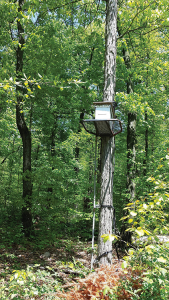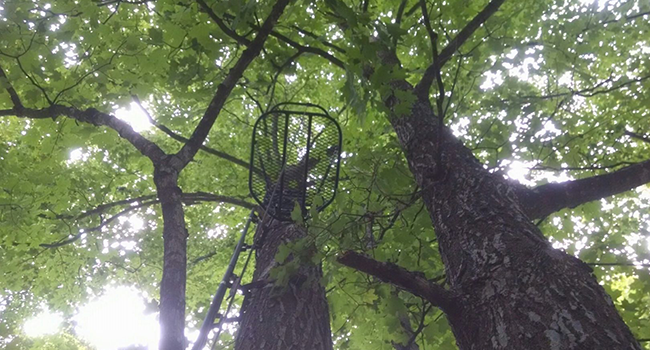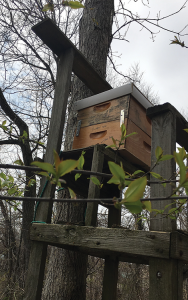By: Will Caverly
Few hobbies have a steeper learning curve than beekeeping.

A typical treestand on a shagbark hickory, complete with a baited cardbord nuc placed on it. Note the climbing sticks and platform are separate.
But hunting arguably involves far more failure and frustration. Whether big game, small game, or in-between game, the hunter can spend days, months, or years without setting eyes on their quarry. Speaking personally, for all the time I spend outdoors, up in trees, pre-season scouting, and otherwise trying to make a successful harvest, I see few animals and get even fewer shots. Like my honey, the end product, sustainable, cage free wild meat, is pound for pound a magnitude more expensive than what I can buy in the store. That said, I love the chess game of hunting in the same way I love the monitoring and interpretation of honey bee behavior: interacting with natural systems on their own terms creates intensely rewarding experiences.
As in beekeeping, hunting equipment stacks up. My treestands lay unused from February to September. Many hunters leave their stands in the woods all year long. I take them down from my public land hunting spots to decrease weathering and the chance of someone stealing my equipment. They sit disassembled in my garage for months, taking up precious space, space I could be using for more beekeeping gear. But last spring, after placing some swarm traps, I had an epiphany. I decided to repurpose some of my hunting equipment this Spring for swarm catching.
As many beekeepers know, baiting swarms involves placing a bait box 15 feet off the ground1. Bees seek out high cavities to avoid predation. This selected adaptation does a few things: the new colony stays out of an animal’s line of sight, the range of their nose, and many predator species don’t scale trees. Bees can rid themselves of many problems through their vertical preference.
In a similar adaptation, treestand hunters climb trees in order to get out of the line of sight of their prey, prevent the animal’s nose from picking up their scent, and get a better view of the woods underneath. Most treestands are designed for placement well above the 15 feet recommended by the swarm trapping literature. Hunters I know want to be at least twenty feet up. They carry the equipment to make it happen quietly, safely, and quickly.
When I first got interested in swarm trapping, I got online and watched people undertake some extraordinarily dangerous climbs. Using aluminum ladders better suited to house painting or cleaning out the gutters, they prop themselves against the tree, ratchet-strapping heavy boxes to trunks or fastening them in branch elbows. Others nail contraptions to the tree in order to support the weight of the bait boxes. Many swarm trappers couldn’t renew their queen pheromone, lemongrass oil, or other attractant without a lot of trouble.
Let’s not reinvent the wheel. Whatever you think about hunting, the sport of harvesting wild game has many participants taking safe climbs into trees, setting up mobile platforms that spare the tree from harm and ensure safety. Furthermore, meeting the bees where they want to hang out is the best way to find them.
I myself have used an old treestand to catch a swarm. The former owners of my property built a homemade stand that stood about 12 feet off the ground. Fred told me he’d hunted from the stand but never got anything. It stood in the same place for years, slowly wearing out. Now it has a nice patina of green mildew and creaks when you shake it. While I’d never get up in it for hunting purposes in its present condition, it held a quick swarm trap I made out of two old, cracked medium supers. I checked it out one day in May and was thrilled to see that a nice, healthy swarm had moved in only a week or two after putting up the bait box.2 That swarm became one of my strongest hives, growing so much that I had to split it midsummer.
This brings up a related observation. Whitetail deer, the most hunted big game species in the United States, prefer edges and transition zones. I often place my stands just inside of the woods from meadows. The old handmade stand on my property borders an agricultural field but is set back in the woods a spell. Swarms tend to be sensitive to temperature, so don’t want to be in full sun3. If you’re already hunting and already setting treestands, or have a hunter friend or family member, you may not even need to take down a hung stand to have a good chance of catching a swarm in that location. Public lands and other kinds of liminal timberland could offer excellent opportunities for wild genetics.
But if you don’t have a treestand, it isn’t hard to find one. They range widely in price. Most I’ve encountered, even the basic models, are extremely durable and will last you the rest of your life if you take care of them. With some luck, you’ll catch a cast swarm from a feral hive, introducing some hearty genetics to your apiary.
Here’s a few pointers on what to look for in a hunting tree stand:
- Time of year: The best time to buy a treestand in most of the USA is after big game hunting season concludes, usually around January in whitetail country. If you thought people quit beekeeping in droves after their failed first attempts, get a load of craigslist after hunting season is over. Cruise your local or online resale outlets after your big game season ends to find a real bargain. Most sporting outfitters also offer sales you can take advantage of for new equipment.
- Safety harness: A system involving a harness on your person and a corresponding belt around the tree are relatively cheap for the potential price of a serious maiming or death. Some new treestands include a safety harness. The safest method is to climb the stand using a harness, then rig up a way to haul the bait box up from the ground. If you don’t want to procure yourself a treestand, you’d do worse than to purchase a safety harness system for when you scale trees. The best safety harness is one that you’ll use as part of your swarm trapping routine.
- Type: Treestands range from “ladder stands”, involving a raised platform accessed by a ladder, to “tree sticks”, a mobile set of ratchet-strapped pieces forming a ladder up the tree, with a separate platform piece. The best stand is the one that you’re able to easily and safely access. But, as a rule of thumb, the “tree stick” stands are designed to scale the gnarliest wolf tree on your property. Since these stands are designed to keep an adult suspended in the air, even your heaviest bait box will be fine in a functioning treestand.
- Placement: If you’re inclined to put a treestand on public land, you want to make sure you’re in compliance with local laws, both in whether you can leave a stand out for long periods and whether it’s legal to bait bees in that area. Otherwise, most stands are dynamic to place and can face south, the preference for most bait hives.
The trapping method I discovered on my own turned out to pay dividends. It’s a synthesis of two hobbies I enjoy in their moment and daydream about the rest of the year. This year, as the temperatures warm up and I’m enjoying venison burgers from my grill, I’ll have my hunting equipment doing double duty and bringing in a different kind of harvest.
1Seeley, et al. “Bait Hives for Honey Bees,” https://ecommons.cornell.edu/handle/1813/2653.
2Bait hive swarm retrieval, Satoyama Homestead, 17 May 2017, https://youtu.be/2pTfxXpmc8o.
3I’ve learned a ton about swarm catching from reading Dr. Leo Sharashkin’s enjoyable columns and on his website, http://www.horizontalhive.com.
Will Caverly is a beekeeper in Pennsylvania and one of the stewards of Satoyama Homestead. The homestead website can be found at satoyamahs.org, where they maintain a blog and record The Original Transplants podcast.








